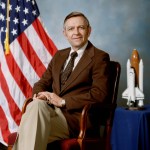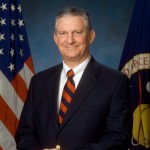
Ellen Ochoa
Johnson Space Center Director, 2013 - 2018
Ellen Ochoa became Johnson Space Center’s 11th center director in 2013. She was only the second woman to lead Johnson and the first Hispanic at its helm.
After earning her doctorate in electrical engineering from Stanford University in 1985, Ochoa accepted a position at Sandia National Labs and later at NASA’s Ames Research Center where she studied optical systems for performing information processing. She is the co-inventor on three patents: an optical inspection system, an optical object recognition method, and a method for noise removal in images.
In 1990, when she was selected to be an astronaut, Ochoa managed the Intelligent Systems Technology Branch at Ames, where she supervised a staff of 35 researching computational systems for spaceflight missions. She went on to fly in space four times and was the first Hispanic woman to do so in 1993. That mission, STS-56, studied the sun’s impact upon the Earth and the planet’s climate. Following STS-56, she flew on STS-66, 96, and 110. On her first three flights, she operated the space shuttle’s remote manipulator system, or Canadarm, and on her last she used the International Space Station’s arm to install the S0 truss—the backbone of the workshop—and to move astronauts during extravehicular activities or spacewalks. She also used her remote manipulator skills to deploy and capture two satellites in space on other missions.

After her final flight in 2002, Ochoa became the deputy director of the Flight Crew Operations Directorate. As deputy, she sat in Mission Control for the launch and landing of the space shuttles, two important bookends of space missions, while the head of FCOD flew to Kennedy Space Center in Florida for those two events. On February 1, 2003, after the Space Shuttle Columbia and crew were lost, she initiated the directorate’s contingency action plan. Ochoa remained deputy until the fall of 2006, when she became director of FCOD.
During launch, the FCOD director represented the crew as leaders were polled on whether conditions were right for liftoff. Once, she was responsible for scrubbing a shuttle launch. Center director Michael L. Coats recalled Ochoa was uncomfortable with exceeding the limits for a hydrogen leak that ground controllers had detected. They previously had agreed to certain limits, and if they fell outside of those requirements, Ochoa explained, the shuttle should not launch. Coats said, “That’s the only case I’m aware of where one individual scrubbed the launch.” He later named her deputy director saying, “Ellen has proven her exceptional capabilities many times in space as well as in her many roles on the ground, including most recently her superb management of Flight Crew Operations.” When he retired at the end of 2012, she became director.

Read Ellen Ochoa’s oral history transcripts
During her tenure, she initiated a concept known as JSC 2.0. Because of changes in the space industry and government funding, Ochoa believed that Johnson could not continue to operate in the same way it had in the past, and she encouraged employees to advance human spaceflight by being lean, agile, responsive, and adaptive. She also oversaw the first successful flight test of the Orion spacecraft known as Exploration Flight Test-1; the selection of four veteran astronauts to fly on the crew capsules then being built by SpaceX and Boeing to ferry crews to the International Space Station; the completion of a new biomedical research building; and the completion of the one-year International Space Station mission, which included astronaut Scott Kelly and cosmonaut Mikhail Kornienko. She also promoted innovation and inclusion initiatives.
In 2018, in her thirtieth year at NASA, Ochoa informed employees she intended to retire. Her youngest son had turned 18, so she wrote it is “a natural point for our family in which to move on to the next phase.” This included moving to Boise, Idaho, and turning her attention to activities of interest like playing the flute, which she had once considered as a possible career.







































